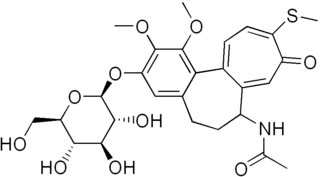 | |
| Clinical data | |
|---|---|
| ATC code |
|
| Identifiers | |
| |
| CAS Number | |
| PubChem CID | |
| ChemSpider | |
| UNII | |
| ChEBI | |
| ChEMBL | |
| CompTox Dashboard (EPA) | |
| Chemical and physical data | |
| Formula | C15H18F3NO |
| Molar mass | 285.310 g·mol−1 |
| 3D model (JSmol) | |
| |
| |
Lanperisone (INN) is a muscle relaxant. [1]
 | |
| Clinical data | |
|---|---|
| ATC code |
|
| Identifiers | |
| |
| CAS Number | |
| PubChem CID | |
| ChemSpider | |
| UNII | |
| ChEBI | |
| ChEMBL | |
| CompTox Dashboard (EPA) | |
| Chemical and physical data | |
| Formula | C15H18F3NO |
| Molar mass | 285.310 g·mol−1 |
| 3D model (JSmol) | |
| |
| |
Lanperisone (INN) is a muscle relaxant. [1]
Chemically and mechanistically related drugs:

Pancuronium is an aminosteroid muscle relaxant with various medical uses. It is used in euthanasia and is used in some states as the second of three drugs administered during lethal injections in the United States.
A muscle relaxant is a drug that affects skeletal muscle function and decreases the muscle tone. It may be used to alleviate symptoms such as muscle spasms, pain, and hyperreflexia. The term "muscle relaxant" is used to refer to two major therapeutic groups: neuromuscular blockers and spasmolytics. Neuromuscular blockers act by interfering with transmission at the neuromuscular end plate and have no central nervous system (CNS) activity. They are often used during surgical procedures and in intensive care and emergency medicine to cause temporary paralysis. Spasmolytics, also known as "centrally acting" muscle relaxant, are used to alleviate musculoskeletal pain and spasms and to reduce spasticity in a variety of neurological conditions. While both neuromuscular blockers and spasmolytics are often grouped together as muscle relaxant, the term is commonly used to refer to spasmolytics only.

Orphenadrine is an anticholinergic drug of the ethanolamine antihistamine class; it is closely related to diphenhydramine. It is a muscle relaxant that is used to treat muscle pain and to help with motor control in Parkinson's disease, but has largely been superseded by newer drugs. It is considered a dirty drug due to its multiple mechanisms of action in different pathways. It was discovered and developed in the 1940s.

Methocarbamol, sold under the brand name Robaxin among others, is a medication used for short-term musculoskeletal pain. It may be used together with rest, physical therapy, and pain medication. It is less preferred in low back pain. It has limited use for rheumatoid arthritis and cerebral palsy. Effects generally begin within half an hour. It is taken by mouth or injection into a vein.

Neuromuscular-blocking drugs, or Neuromuscular blocking agents (NMBAs), block transmission at the neuromuscular junction, causing paralysis of the affected skeletal muscles. This is accomplished via their action on the post-synaptic acetylcholine (Nm) receptors.

Chlormezanone is a drug used as an anxiolytic and a muscle relaxant.

Mephenesin (INN) is a centrally acting muscle relaxant. It can be used as an antidote for strychnine poisoning. Mephenesin however presents with the major drawbacks of having a short duration of action and a much greater effect on the spinal cord than the brain, resulting in pronounced respiratory depression at clinical doses and therefore a very low therapeutic index. It is especially dangerous and potentially fatal in combination with alcohol and other depressants. Mephenesin was used by Bernard Ludwig and Frank Berger to synthesize meprobamate, the first tranquilizer to see widespread clinical use. Mephenesin is no longer available in North America but is used in Italy and a few other countries. Its use has largely been replaced by the related drug methocarbamol, which is better absorbed.

Tolperisone is a centrally acting skeletal muscle relaxant used for the treatment of increased muscle tone associated with neurological diseases. It has been used since the 1960s.
Suxethonium is a depolarising muscle relaxant which is presented as a dry powder in an ampoule. This is re-constituted with sterile water prior to use. It is available in Australia as a schedule 4 drug, and the US.

Thiocolchicoside is a muscle relaxant with anti-inflammatory and analgesic effects. Its mechanism of action is unknown, but it is believed to be act via antagonism of nicotinic acetylcholine receptors (nAchRs). However, it also appears to be a competitive antagonist of GABAA and glycine receptors. As such, it has powerful convulsant activity and should not be used in seizure-prone individuals.

Styramate is a muscle relaxant and anticonvulsant drug. At therapeutic doses, it does not produce significant sedative effects.

Mephenoxalone is a muscle relaxant and mild anxiolytic. It inhibits neuron transmission, relaxing skeletal muscles by inhibiting the reflex arc. As the effect of muscle relaxation, mephenoxalone affects mental condition, and is also a treatment for nervousness and anxiety.

Afloqualone (Arofuto) is a quinazolinone family GABAergic drug and is an analogue of methaqualone developed in the 1970s by a team at Tanabe Seiyaku. It has sedative and muscle-relaxant effects resulting from its agonist activity at the β subtype of the GABAa receptor and has had some clinical use, although it causes photosensitization as a side-effect that can cause skin problems such as dermatitis.

Metocurine is a muscle relaxant through neuromuscular blockade. It is excreted entirely through the kidneys and therefore should not be used in patients with kidney failure.

Chlorphenesin carbamate is a centrally acting muscle relaxant used to treat muscle pain and spasms. Chlorphenesin carbamate is no longer used for this purpose in most developed nations due to the availability of much safer spasmolytics such as benzodiazepines.

Candocuronium iodide is a aminosteroid neuromuscular-blocking drug. Its use within anesthesia for endotracheal intubation and for providing skeletal muscle relaxation during surgery or mechanical ventilation was briefly evaluated in clinical studies in India, though further development was discontinued due to attendant cardiovascular effects, primarily tachycardia that was about the same as the clinically established pancuronium bromide. Candocuronium demonstrated a short duration in the body, but a rapid onset of action. It had little to no ganglion blocking activity, with a greater potency than pancuronium.

BW A444U was an experimental neuromuscular blocking drug or skeletal muscle relaxant in the category of non-depolarizing neuromuscular-blocking drugs, intended to be used adjunctively in surgical anesthesia to facilitate endotracheal intubation and to provide skeletal muscle relaxation during surgery or mechanical ventilation. It was synthesized and developed in the early 1980s.

Inaperisone (INN) is a muscle relaxant.
Silperisone (INN) is a muscle relaxant.
An analgesic adjuvant is a medication that is typically used for indications other than pain control but provides control of pain (analgesia) in some painful diseases. This is often part of multimodal analgesia, where one of the intentions is to minimize the need for opioids.